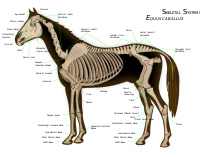
Photo from wikipedia
Cho et al. (2018) recently described the topographical anatomy of the intestine during the embryonic stage using sagittal histological sections (Clinical Anatomy 31:583–592, 2018). Strikingly, out of 17 samples, 11… Click to show full abstract
Cho et al. (2018) recently described the topographical anatomy of the intestine during the embryonic stage using sagittal histological sections (Clinical Anatomy 31:583–592, 2018). Strikingly, out of 17 samples, 11 “abnormal” samples were found with crown-ramp length (CRL) of 15 and 25 mm, because the descending colon (DC) was herniated in the extraembryonic coelom (hernia sac). On the contrary, no abnormal samples were detected on 10 samples with CRL of 26 and 39 mm, and 7 samples had CRL of 41 and 56 mm. They provided no three-dimensional (3D) reconstruction but presented only sagittal histological sections. Therefore, it is extremely difficult to comprehend in detail, especially the spatial relationship. Three-dimensional information, such as exact location and structure of complicated intestinal tracts, location of the cecum, and length of the colon and intestine, will help accurate discrimination of normal and abnormal development. Furthermore, they argued a broad range of embryo specimens between CRL of 15 and 56 mm, which may correspond the Carnegie stage (CS18) to CS23 and even larger samples (O’Rahilly and Müller, 1987). Dynamic and complicated morphological changes were observed in that period. The intestinal tract especially elongates much faster than the CRL (Ueda et al., 2016). Therefore, discussion on whether “normal” development occurred or not should be considered. We have previously described the morphology and morphometry of physiological umbilical hernia during the embryonic period using Kyoto Collection samples (Ueda et al., 2016). The intestinal tract from the stomach to rectum was 3D reconstructed using magnetic resonance imaging. The small intestine forms the cranial limb of the loop and some of the caudal limb, whereas the colon forms the remainder of the caudal limb. Thus, the cecum was located at the caudal limb of the intestinal loop (IL), which showed that the length of the colon in the extraembryonic coelom is very short as compared with that of the small intestine (Nagata et al., 2019; Ueda et al., 2016). The colon-forming caudal part of the IL returns in the abdominal cavity, which passes promptly to the rectum. The course of the tract was smoothly curved at the lateral view with vague infection point but almost straightly at the ventral view (Fig. 1; see Ueda et al., 2016, fig. 2C). At CS18, the IL formed as simple hairpin with almost 90 rotation around the superior mesenteric artery (SMA). The cranial limb was located at the right side and caudal limb including the cecum at the left side in the hernial ring. According to development until CS23, the form of IL is elongated and complicated, whereas the intestinal tract in the abdominal cavity was relatively similar. The starting point of IL was almost on the midsagittal plane, whereas the colon tract passes just at the left side of the median plane. In our study, the colon tract was similar in all 34 samples between CS18 and CS23 (CRL range, 12.8–23.2 mm). No looping and different location of the colon were observed. Discriminating the segments of the colon was avoided, although a vague infection point was recognized, because the proof of blood supply from the SMA or inferior mesenteric artery (IMA) for these segments was required for the discrimination. Soffers et al. (2015) also showed the position of the intraabdominal distal colon to the rectum with histological section, which is compatible with that of our study. Moreover, the border between the colon segment supported by the SMA and IMA (Colic bend) was shown (Soffers et al., 2015, asterisk in fig. 10). The border was close to the colic bend (a point near the left colic flexure in adults), which remains as a vague infection point because DC was detached from the dorsal abdominal wall. The mesentery for IL and DC was notably continuous, although the latter is not so long to allow the DC into hernial sac. Similar observation was described in another study (Dott, 1923, figs. 170–172). Such location of the colon may be recognized on a globally famous 3D models using the “Blechscmidt collection” (Blechscmidt, 1961, fig. 103). No abnormal samples of “DC-Jejunum outside” were detected, with larger samples having CRL26 and CRL39 mm in Cho et al.’s study. The samples may correspond to samples at CS23 and even larger samples, which remains in herniation and transition phases (on the way to return to the abdominal cavity; Nagata et al., 2019). We described the intestinal tract with 3D reconstruction in the corresponding periods. The running course from the colon to the rectum in herniated phase (CRL32 mm) was almost similar to that in CS23 samples, whereas segments of sigmoid colon, DC, and transverse colon may be discernable in the transition phase (CRL37, CRL41, and CRL43 mm) by forming a recognizable